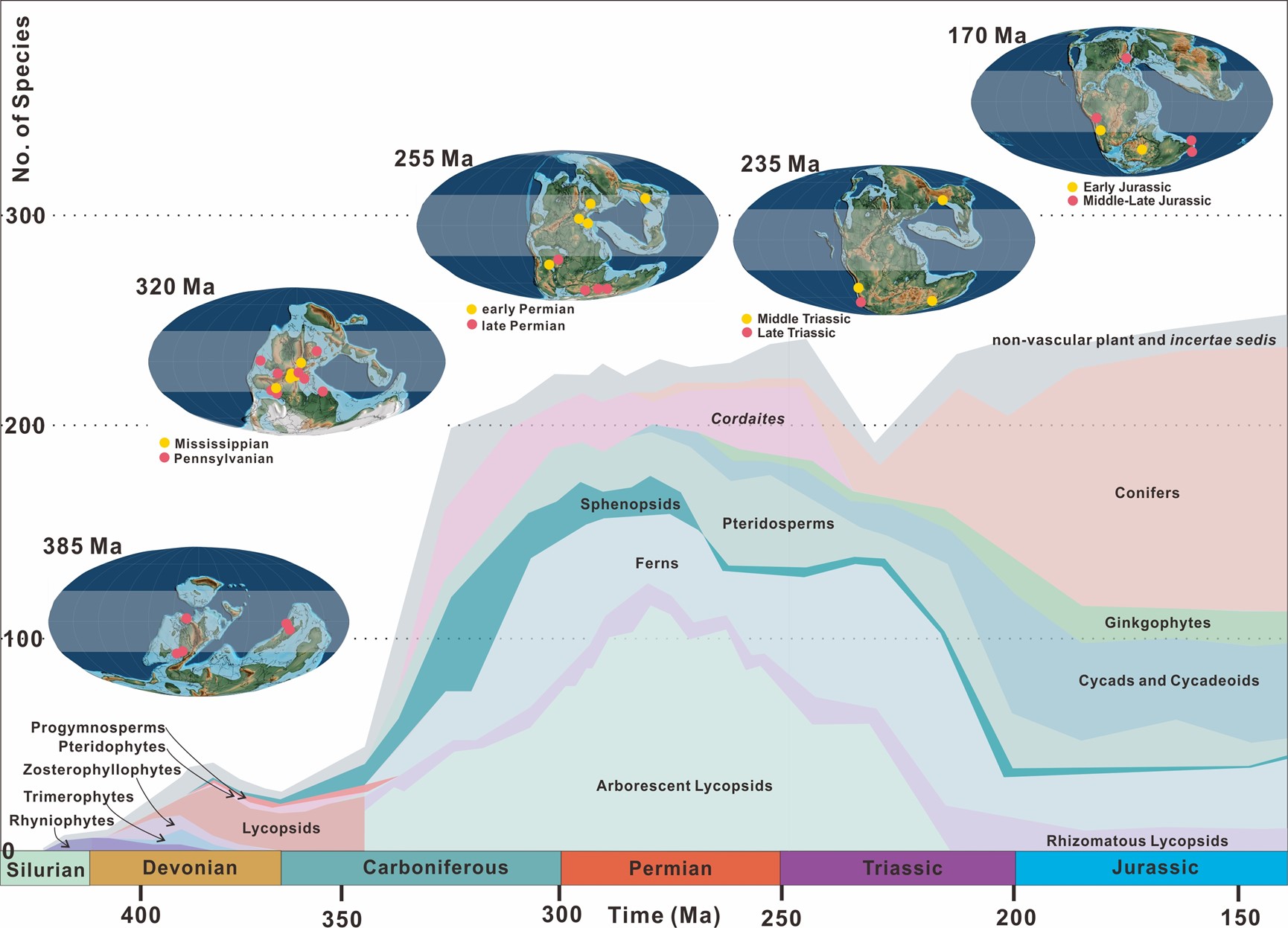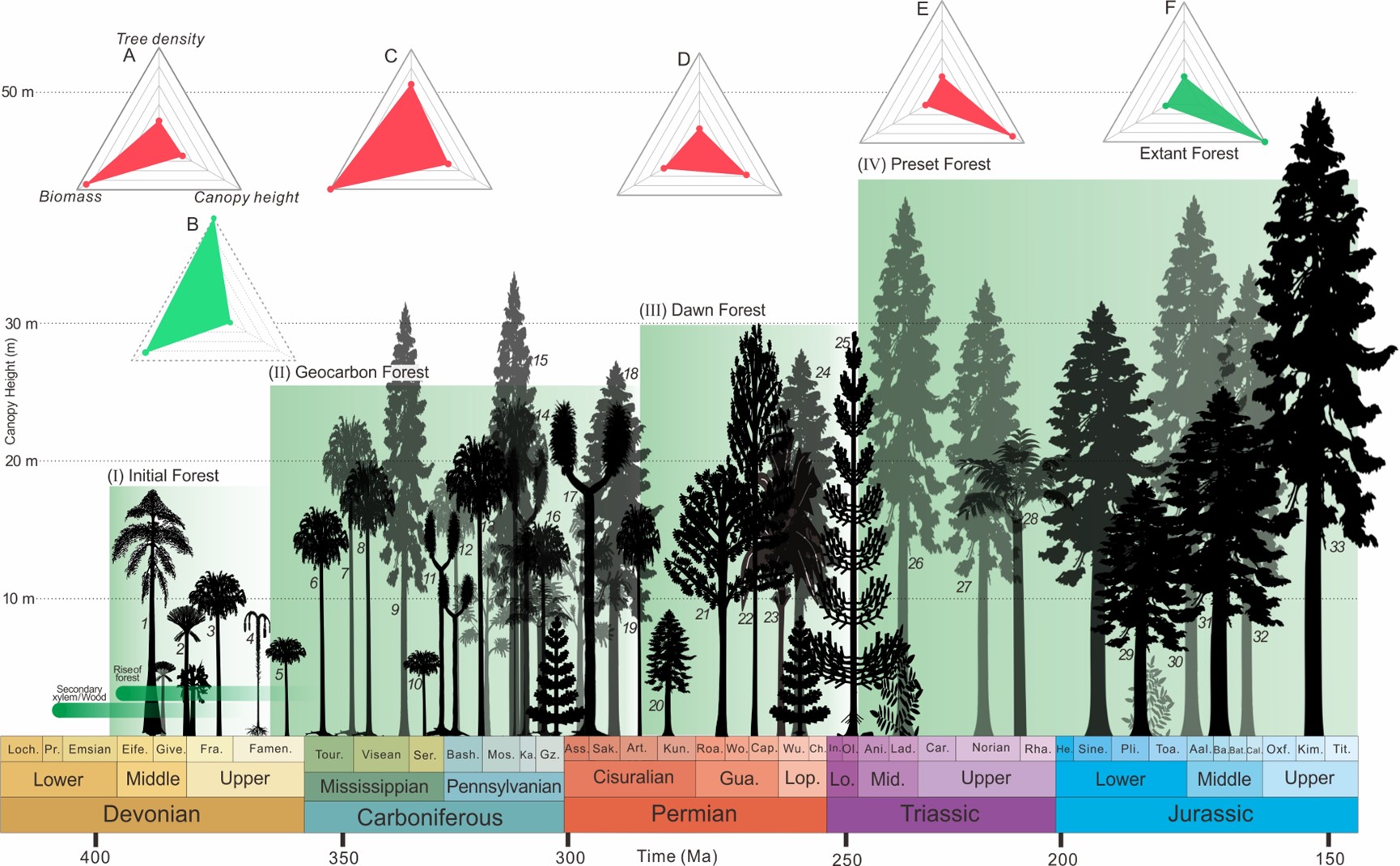Recently, the Early Land Plant Evolution working group of Nanjing Institute of Geology and Palaeontology, Chinese Academy of Sciences (NIGPAS), led by Prof. XU Honghe, compiled and analyzed an up-to-date dataset of in situ forests from Middle Devonian to Jurassic. The research result was published in Earth-Science Reviews.
Forests, as an essential part of the terrestrial ecosystem and a unique vegetation landscape have existed since at least 390 Ma, from the pioneering Devonian forests to towering conifer forests of the Mesozoic and, ultimately, to the extant forest ecosystems dominated by angiosperms. Forests dramatically influence Earth’s climate and environment through physical, chemical and biological processes.
Dozens of in situ fossil forests have been reported worldwide as the direct evidence and contributed to our understandings of forest evolution. Consequently, fossil forests are summarized as, the initial forest in the Devonian, composed by progymnosperms and cladoxylopsids, and lycopsid forests occupied coal-forming swamps in the Carboniferous, the actual reconstruction and landscape heterogeneity in early Permian Wuda Forest, and the polar forest ecosystems reveled from Antarctica in situ forests. As a result, much data on forest composition, growth and distribution of individual forest-forming trees keep accumulating, nevertheless, the community structure and dynamic evolution on these forests are still awaiting to be revealed, especially in view of ecology and using multiple spatial analysis methods.
In this study, the research group review and collect paleobotanical and geological data of 38 pre-angiosperm in situ forests ranging from the Middle Devonian to Jurassic and quantitatively assess the forest community structure in terms of distribution, forest composition, canopy height, tree density, biomass, forest stand structure, and spatial pattern.
The results show that canopy height increased in two distinct phases: first during the Late Devonian–Early Carboniferous, and again in the Middle Triassic–Late Jurassic. Biomass reached its peak in the Middle Devonian–Late Carboniferous lycopsid forests, then stabilized to levels similar to those of extant forests after the Middle Triassic. Tree density was highest in the Devonian–Carboniferous, especially in lycopsid forests, but aligned with that of modern forests after gymnosperms became dominant in the Middle Triassic. Throughout these periods, spatial patterns remained predominantly aggregated and similar to those seen in extant forests.
Furthermore, the research group identified four evolutionary stages of fossil forests. The Initial Forest stage, spanning from the Eifelian to Frasnian, was characterized by diverse composition, moderate biomass and tree density, and low canopy height. This was followed by the Geocarbon Forest stage, from the late Famennian to early Permian, during which lycopsids dominated and both biomass and tree density reached the highest levels in geologic history. The Dawn Forest stage, from the middle Permian to Early Triassic, exhibited increased canopy height but lower tree density and biomass. Finally, the Preset Forest stage, extending from the Middle Triassic to the Late Cretaceous, was marked by gymnosperm dominance and a further increase in canopy height.
"In situ forests provide unique window for understanding forest structure. Our study is the first to assess fossil forests using modern ecological indicators, offering a new perspective on the evolution of forest ecosystems," says Prof. XU.
This study was supported by National Key R&D Program of China and published as below.
Reference: Liu, B. C., Xu, H. H., Wang, K., 2025. Quantitative assessment of community structure of fossil forests from the Devonian to Jurassic periods. Earth-Science Reviews. https://doi.org/10.1016/j.earscirev.2025.105295.

Fig 1. Macroplant species diversity and several main in situ fossil forests in the paleogeographic map during from the Silurian to Jurassic Period.

Fig 2. Spatial patterns and forest stand structure of Devonian forests.

Fig 3. Evolution forests from the Middle Devonian Epoch to the Jurassic Period
Download:
